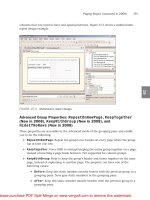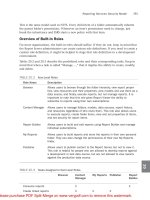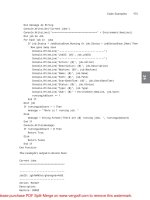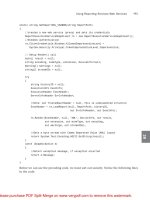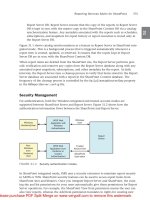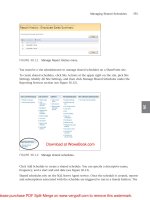Tài liệu McGraw-Hill - Microsoft SQL Server 2008 Reporting Services (2008)01 docx
Bạn đang xem bản rút gọn của tài liệu. Xem và tải ngay bản đầy đủ của tài liệu tại đây (728.53 KB, 40 trang )
REPORTING
SERVICES
Microsoft
®
SQL Server
™
2008
About the Author
Brian Larson is a Phi Beta Kappa graduate of Luther College in Decorah, Iowa,
with degrees in physics and computer science. Brian has 23 years of experience in the
computer industry and 19 years experience as a consultant creating custom database
applications. He is currently the Chief of Technology for Superior Consulting
Services in Minneapolis, Minnesota, a Microsoft Consulting Partner for Reporting
Services. Brian is a Microsoft Certified Solution Developer (MCSD) and a
Microsoft Certified Database Administrator (MCDBA).
Brian served as a member of the original Reporting Services development team
as a consultant to Microsoft. In that role, he contributed to the original code base of
Reporting Services.
Brian has presented at national conferences and events, including the SQL
Server Magazine Connections Conference, the PASS Community Summit, and the
Microsoft Business Intelligence Conference, and has provided training and mentoring
on Reporting Services across the country. He has been a contributor and columnist
for SQL Server Magazine. In addition to this book, Brian is the author of Delivering
Business Intelligence with Microsoft SQL Server 2008, also from McGraw-Hill.
Brian and his wife Pam have been married for 23 years. Pam will tell you that
their first date took place at the campus computer center. If that doesn’t qualify
someone to write a computer book, then I don’t know what does. Brian and Pam
have two children, Jessica and Corey.
About the Technical Editor
Brian Welcker is a Senior Product Manager in Microsoft’s Health Solution Group,
helping to build software solutions for hospitals around the world. Before joining the
Health Solutions Group, Brian was Group Program Manager for Microsoft SQL
Server Reporting Services, where his team was focused on delivering the premier
managed, ad hoc, and developer reporting platform as part of SQL Server and Visual
Studio. A 12-year Microsoft veteran, Brian was one of the founding members of the
Reporting Services team; he has also worked as the lead program manager for SQL
Server Meta Data Services, as well as a technical evangelist in Microsoft’s Developer
Relations Group. He joined Microsoft after working for a healthcare software
company in his home town of Raleigh, North Carolina. Brian resides in Seattle,
Washington with his wife and two children.
Copyright © 2009 by The McGraw-Hill Companies. Click here for terms of use.
Microsoft
®
SQL Server
™
2008
REPORTING
SERVICES
Brian Larson
New York Chicago San Francisco Lisbon
London Madrid Mexico City Milan
New Delhi San Juan Seoul Singapore
Sydney Toronto
Copyright © 2009 by The McGraw-Hill Companies. All rights reserved. Manufactured in the United States of America. Except as permitted under
the United States Copyright Act of 1976, no part of this publication may be reproduced or distributed in any form or by any means, or stored in
a database or retrieval system, without the prior written permission of the publisher.
0-07-154809-2
The material in this eBook also appears in the print version of this title: 0-07-154808-4.
All trademarks are trademarks of their respective owners. Rather than put a trademark symbol after every occurrence of a trademarked name, we
use names in an editorial fashion only, and to the benefit of the trademark owner, with no intention of infringement of the trademark. Where such
designations appear in this book, they have been printed with initial caps.
McGraw-Hill eBooks are available at special quantity discounts to use as premiums and sales promotions, or for use in corporate training
programs. For more information, please contact George Hoare, Special Sales, at or (212) 904-4069.
TERMS OF USE
This is a copyrighted work and The McGraw-Hill Companies, Inc. (“McGraw-Hill”) and its licensors reserve all rights in and to the work. Use
of this work is subject to these terms. Except as permitted under the Copyright Act of 1976 and the right to store and retrieve one copy of the
work, you may not decompile, disassemble, reverse engineer, reproduce, modify, create derivative works based upon, transmit, distribute,
disseminate, sell, publish or sublicense the work or any part of it without McGraw-Hill’s prior consent. You may use the work for your own
noncommercial and personal use; any other use of the work is strictly prohibited. Your right to use the work may be terminated if you fail to
comply with these terms.
THE WORK IS PROVIDED “AS IS.” McGRAW-HILL AND ITS LICENSORS MAKE NO GUARANTEES OR WARRANTIES AS TO THE
ACCURACY, ADEQUACY OR COMPLETENESS OF OR RESULTS TO BE OBTAINED FROM USING THE WORK, INCLUDING ANY
INFORMATION THAT CAN BE ACCESSED THROUGH THE WORK VIA HYPERLINK OR OTHERWISE, AND EXPRESSLY DISCLAIM
ANY WARRANTY, EXPRESS OR IMPLIED, INCLUDING BUT NOT LIMITED TO IMPLIED WARRANTIES OF MERCHANTABILITY
OR FITNESS FOR A PARTICULAR PURPOSE. McGraw-Hill and its licensors do not warrant or guarantee that the functions contained in the
work will meet your requirements or that its operation will be uninterrupted or error free. Neither McGraw-Hill nor its licensors shall be liable
to you or anyone else for any inaccuracy, error or omission, regardless of cause, in the work or for any damages resulting therefrom.
McGraw-Hill has no responsibility for the content of any information accessed through the work. Under no circumstances shall McGraw-Hill
and/or its licensors be liable for any indirect, incidental, special, punitive, consequential or similar damages that result from the use of or inabil-
ity to use the work, even if any of them has been advised of the possibility of such damages. This limitation of liability shall apply to any claim
or cause whatsoever whether such claim or cause arises in contract, tort or otherwise.
DOI: 10.1036/0071548084
This book is dedicated to my family. To my children, Jessica and Corey,
who gave up many hours of “dad time” during the writing of this book.
And especially to my wife, Pam, who, in addition to allowing me to
commit to this project, gave countless hours of her own
time to make sure things were done right.
This page intentionally left blank
vii
Contents at a Glance
Part I Getting Started
Chapter 1 Let’s Start at the Very Beginning 3
Chapter 2 Putting the Pieces in Place: Installing Reporting Services 23
Part II Report Authoring
Chapter 3 DB 101: Database Basics 65
Chapter 4 A Visit to Emerald City: The Report Wizard 111
Chapter 5 Removing the Training Wheels: Building Basic Reports 171
Chapter 6 Graphic Expression: Using Charts, Images, and Gauges 219
Chapter 7 Kicking It Up a Notch: Intermediate Reporting 297
Chapter 8 Beyond Wow: Advanced Reporting 365
Chapter 9 A Leading Exporter: Exporting Reports to Other Rendering Formats 441
Part III Report Serving
Chapter 10 How Did We Ever Manage Without You? The Report Manager 467
Chapter 11 Delivering the Goods: Report Delivery 529
Chapter 12 Extending Outside the Box: Customizing Reporting Services 571
Part IV Appendixes
Appendix A Report Item Reference 637
Appendix B Web Service Interface Reference 709
Appendix C Ad Hoc Reporting 781
Index 823
This page intentionally left blank
ix
Contents
Foreword xvii
Acknowledgments xix
Introduction xxi
The Galactic Database and Other Supporting Materials xxii
Part I Getting Started
Chapter 1 Let’s Start at the Very Beginning 3
Sharing Business Intelligence 5
The Need to Share . . . 5
Possible Solutions 6
Microsoft Reporting Services 8
Report Authoring Architecture . 10
The Business Intelligence Project Type . 11
Report Structure 12
Report Designer 14
Standalone Report Builder 16
Report-Serving Architecture 17
Report Server 18
Report Delivery . 20
Diving In 22
Chapter 2 Putting the Pieces in Place: Installing Reporting Services . 23
Preparing for the Installation 24
The Parts of the Whole . . 24
Editions of Reporting Services 27
Types of Reporting Services Installations 29
Installation Requirements 34
Other Installation Considerations 35
The Installation Process . 39
The SQL Server 2008 Installation . 39
The Reporting Services Configuration Manager 49
For more information about this title, click here
x Microsoft SQL Server 2008 Reporting Services
Common Installation Issues 60
Administrative Rights 60
Server Components Not Shown on the Feature Selection Screen 60
Installation Error 2755 . 60
Reporting Services and IIS on the Same Server 61
The Repair Utility and Installation Log File 61
Spending Some Time in Basic Training . 61
Part II Report Authoring
Chapter 3 DB 101: Database Basics 65
Database Structure 66
Getting Organized 66
Retrieving Data . 76
Galactic Delivery Services . 84
Company Background . 85
Querying Data 88
The SELECT Query 90
On to the Reports 108
Chapter 4 A Visit to Emerald City: The Report Wizard . 111
Obtaining the Galactic Database 112
Your First Report . 112
The Customer List Report 113
An Interactive Table Report 137
The Customer-Invoice Report 137
Creating Matrix Reports 153
The Invoice-Batch Number Report . 153
Report Parameters 160
The Parameterized Invoice-Batch Number Report 160
Flying Solo 169
Chapter 5 Removing the Training Wheels: Building Basic Reports 171
Riding Down Familiar Roads . 172
The Transport List Report 172
The Tablix and Data Regions . 195
The Repair Count By Type Report . . 197
New Territory 205
The Transport Information Sheet 206
Getting Graphical 218
Contents xi
Chapter 6 Graphic Expression: Using Charts, Images, and Gauges 219
Chart Your Course 220
The Deliveries versus Lost Packages Chart . 220
The Fuel Price Chart 236
The Fuel Price Chart, Version 2 244
The Business Type Distribution Chart 247
The Days in Maintenance Chart 250
Gauging the Results . 257
The Digital Dashboard . 257
Image Is Everything . 273
Conference Nametags . 275
Conference Place Cards 282
The Rate Sheet Report . 288
Building Higher 295
Chapter 7 Kicking It Up a Notch: Intermediate Reporting . 297
Never Having to Say “I’m Sorry” . 298
The Report Template . . . 299
Handling Errors in Reports 306
The Employee Time Report 307
Data Caching During Preview 323
The Employee List Report . 324
The Employee Mailing Labels Report 335
The Overtime Report . 343
The Revised Employee Time Report 351
Under the Hood 359
Viewing the RDL 359
Practicing Safe Source 361
Using Visual SourceSafe . 362
Advance, Never Retreat . 364
Chapter 8 Beyond Wow: Advanced Reporting 365
Speaking in Code 366
The Delivery Status Report . 367
The Lost Delivery Report 377
The Customer List Report—Revisited 386
Payroll Checks 389
xii Microsoft SQL Server 2008 Reporting Services
The Weather Report 397
The Delivery Analysis Report 404
Reports Within Reports . 411
The Employee Evaluation Report . . 412
The Invoice Report 424
Interacting with Reports 428
The Invoice Front-End Report 429
The Transport Monitor Report 432
A Conversion Experience 437
The Paid Invoices Report 437
What’s Next 440
Chapter 9 A Leading Exporter: Exporting Reports to Other Rendering Formats 441
A Report in Any Other Format Would Look as Good 443
Exporting and Printing a Report 443
Presentation Formats . 445
TIFF Image Presentation Format . 447
Adobe PDF Presentation Format . 450
Web Archive Presentation Format . 452
Excel Presentation Format 455
Word Presentation Format 458
Printed Presentation Format 459
Data Exchange Formats . 460
Comma-Separated Values (CSV) Data Exchange Format 460
XML Data Exchange Format 461
Call the Manager 464
Part III Report Serving
Chapter 10 How Did We Ever Manage Without You? The Report Manager 467
Folders 468
The Report Manager . 469
Moving Reports and Supporting Files to the Report Server 472
Deploying Reports Using the Report Designer 472
Uploading Reports Using Report Manager 479
Uploading Other Items Using Report Manager . 487
Uploading Reports Using .NET Assemblies 491
Modifying Reports from the Report Server 500
Contents xiii
Managing Items in Folders . 502
Moving Items Between Folders 502
Deleting a Folder . 503
Renaming a Folder . 504
Seek and Ye Shall Find: Search and Find Functions 504
Searching for a Report . 504
Finding Text Within a Report . 505
Printing from Report Manager . 506
Printing Options 506
Managing Reports on the Report Server 507
Security 508
Roles 511
Linked Reports . 524
Creating a Linked Report 525
Delivering the Goods 528
Chapter 11 Delivering the Goods: Report Delivery 529
Caching In 530
Report Caching 531
Enabling Report Caching 534
Execution Snapshots 539
Enabling Execution Snapshots 539
Report History 542
Enabling Report History . 542
Managing Report History Snapshots 546
Updating Report Definitions and Report History Snapshots 548
Subscriptions . 549
Standard Subscriptions . 549
Managing Your Subscriptions 554
Data-Driven Subscriptions 555
Site Settings 563
The General Site Settings Page . 563
Other Pages Accessed from the Site Settings Page 565
Managing Reporting Services Through the SQL Server Management Studio 566
Additional Settings 569
A Sense of Style 569
The ReportingServices Style Sheet . 569
Building On . . 570
xiv Microsoft SQL Server 2008 Reporting Services
Chapter 12 Extending Outside the Box: Customizing Reporting Services . 571
Using Reporting Services Without the Report Manager 572
URL Access 572
Web Service Access 585
The Report Viewer Control 589
SharePoint Web Parts 595
Reporting Services Utilities 597
Custom Security 608
Authentication and Authorization . 609
Issues with Custom Security 611
Creating a Custom Security Extension . 613
Deploying a Custom Security Extension . 621
Using the Custom Security Extension 627
Other Extensions 629
Best Practices 629
Report-Authoring Practices . 629
Report Deployment Practices . 631
Where Do We Go from Here? . 633
Part IV Appendixes
Appendix A Report Item Reference . 637
Report Objects 638
Layout Areas 638
Data Regions 639
Report Items 645
Property Reference 647
Properties 647
Appendix B Web Service Interface Reference 709
Reporting Services Web Service 710
Creating a Web Reference . . 710
Credentials 711
Compatibility 712
ReportExecution2005 Properties . 712
ReportExecution2005 Methods 713
ReportService2005 Properties 721
Contents xv
ReportService2005 Methods 722
ReportService2006 . . . . 755
ReportService2005 and ReportExecution2005 Web Service Classes . 757
Appendix C Ad Hoc Reporting 781
The Report Model . 782
Creating a Report Model 783
Creating Reports with the Report Builder 800
Report Builder Basics 800
Creating a Table Layout Report 805
Creating a Matrix Layout Report 817
Creating a Chart Layout Report . 819
Give It a Try . 822
Index 823
This page intentionally left blank
xvii
Foreword
A
t the end of 2005, the Reporting Services development team had some tough
decisions to make. Unlike most of the SQL Server development team, who
had been working on the 2005 release for close to five years, it had only
been a year and a half since we shipped the first version of Reporting Services. In that
same timeframe, we shipped two service packs, acquired a new ad hoc reporting tool
that we delivered as Report Builder, and built a set of report controls that shipped in
Visual Studio 2005. The follow-up release, code-named “Katmai,” was scheduled for a
relatively quick two- to three-year turnaround.
During this time, we also learned a lot about how people were using Reporting
Services. When we started development, our initial assumption was that customers
wanted to enable web-based delivery of reports with small to medium-sized data sets.
While this was the case for most customers, there was another set of users that wanted
to be able to export reports as single documents with up to several thousand pages.
As the memory required for generating these reports could be far beyond the actual
memory available on the server, supporting this scenario wasn’t a trivial task. In fact,
it would require a large development effort that would consume most of the schedule
allocated for the 2008 release. At the same time, users had also requested a number of
smaller features that would make their lives easier and their reports better. We couldn’t
fit both, so a decision had to be made.
After much debate, we decided to take a long-term approach and build a new engine
to support report scalability. New reporting features were put on the back burner until
this work was completed. This means that while you won’t see as many new “bells
and whistles” in the 2008 release, there has been a massive amount of work below the
surface to ensure that Reporting Services can handle your biggest reporting workloads.
In the end, we did manage to squeeze in quite a few nice features into the release that
you will like, even if you aren’t pushing the bounds of scalability.
At the end of 2007, it was my turn to make a tough decision. I had been working on
the SQL Server team for over ten years, with six of those on Reporting Services. While
I was extremely proud of the team that we had assembled and excited by the upcoming
release of SQL Server 2008, I felt that it was time to move on to new challenges. This
January, I moved to Microsoft’s new Health Solutions Group, where I am the product
manager for a new line of software applications for hospitals. I still keep in touch with
the Reporting Services development team and have been trying out the newest features
as the product approaches release.
Copyright © 2009 by The McGraw-Hill Companies. Click here for terms of use.
xviii Microsoft SQL Server 2008 Reporting Services
Brian Larson was one of the early proponents of Reporting Services and completed
the first edition of this book just as we wrapped up the work on the first release. While
many other Reporting Services books have appeared on the market, I always considered
Brian’s book to be the best all-around introduction to the product. I enjoyed working
with Brian on the first two editions of this book and was excited when he asked me to
assist with this update. The new release of Reporting Services is the most powerful and
flexible yet. Whether you are a seasoned professional or a first-time user, I hope that
you use the information and techniques presented in this book to get the most out of
the product.
—Brian Welcker
Senior Product Manager
Microsoft Health Solutions Group
xix
Acknowledgments
A
journey of a thousand miles begins with a single step.” Perhaps this book
project was not a journey of a thousand miles, although it seemed that way
in the early hours of the morning with a deadline approaching. Be that as it
may, it is possible to identify the first step in this whole process. A coworker of mine at
Superior Consulting Services, Marty Voegele, was between assignments, on-the-bench,
in consultant-speak. Marty was bored, so he decided to take matters into his own
hands. Marty had previously consulted to Microsoft and still had contacts in the SQL
Server area. He made a few phone calls and before long, Marty was again consulting to
Microsoft, this time creating something called Rosetta.
As additional work was added, I had the opportunity to take on part of this
assignment as well. It was both challenging and exciting working on code that you
knew would be part of a major product from a major software company. What was
perhaps most exciting was that Rosetta seemed to be a tool that would fill several needs
we had identified while developing custom applications for our own clients.
As the beta version of what was now called Reporting Services was released, a brief
introductory article on Reporting Services appeared in SQL Server Magazine. One of
the sales representatives here at Superior Consulting Services, Mike Nelson, decided
this would be a nice bit of marketing material to have as we trumpeted our involvement
with Reporting Services. One thing led to another, and before we knew it, Mike
had offered Marty’s and my services to write a more in-depth article for SQL Server
Magazine. This article became the cover article for the December 2003 issue and has
become known as the “Delightful” article. (You’ll have to read the first paragraph of the
article to understand why.) It is now available on MSDN.
This was where I grabbed the map and compass, and decided on the next path.
Because the magazine article came out fairly well, I decided to write a book on the
topic. Marty informed me that writing a 700-page book would probably make his
fingers fall off, so I could take this next step on my own. So, here we are today, one book
and two revisions later.
All of this is a rather lengthy way of saying that I owe a big thank you to Marty and
Mike. Without a shadow of a doubt, this book would not have happened without them.
In addition to the contributions already stated, I want to thank Marty for helping to
keep me up-to-speed on Reporting Services information and newsgroup postings. We
have learned a great deal preparing presentations on Reporting Services and providing
Reporting Services solutions for clients.
Copyright © 2009 by The McGraw-Hill Companies. Click here for terms of use.
xx Microsoft SQL Server 2008 Reporting Services
I also want to thank John Miller, the owner of Superior Consulting Services. John
hired me as his first employee eleven years ago to be Superior’s Chief of Technology. He
has supported our efforts on Reporting Services and made it a focus area at Superior
Consulting. Without John’s founding of Superior Consulting Services and his bringing
together people such as Marty and Mike, none of this would have come into being.
I need to extend a big thank you to Brian Welcker and the rest of the Reporting
Services development team. Their guidance and patience during development is much
appreciated. The information they were able to provide during the creation of this book
has enhanced the final product you are now holding.
I also want to thank the entire group at McGraw-Hill, especially Wendy Rinaldi,
who has worked with me through two books and three revised editions. The assistance,
guidance, professionalism, and humor of the editorial staff have made this project
much easier. The attention that McGraw-Hill has given this project has been truly
overwhelming.
Last, but certainly not least, I want to thank my wife, Pam, for all her efforts and
understanding. Not only did she agree to my taking personal time to write and revise
this book, but she took it upon herself to proofread every page and work through every
sample report. You, as a reader, are greatly benefiting from her efforts.
I also want to thank you, the reader, for purchasing this book. My hope is that it will
provide you with an informative overview, steady guide, and quick reference as you use
Reporting Services.
Best wishes,
Brian Larson
xxi
Introduction
M
icrosoft SQL Server 2000 Reporting Services and Microsoft SQL Server
2005 Reporting Services were exciting products. With the addition of the
tablix and gauge data regions, the enhancements to the chart data region,
and the complete re-architecting of the rendering engine, Microsoft SQL Server 2008
Reporting Services is even more exciting. Never has there been a product with so much
potential for sharing business information with such ease of use and at such a reasonable
price. Anyone who has ever struggled to find a way to efficiently share database
information across an enterprise will see a reason to be delighted with this product.
Now I will admit that I may not be unbiased when expressing this opinion. I did
have the opportunity to create a small piece of what has now become Reporting
Services. But my excitement goes beyond that.
The main reason I get excited about Reporting Services is because I have been a
database application developer for 19 years. I have fought with various reporting tools.
I have struggled to find a way to efficiently share data between far-flung sales offices
and the corporate headquarters. I have researched enterprise-wide reporting systems and
started salivating when I saw the features they offered, only to have my hopes dashed
when I looked at the licensing fees. I have shaken my fist at the computer screen and
screamed, “There must be a better way!”
With Reporting Services, there is. During the past five years, my colleagues and I at
Superior Consulting Services have had the opportunity to incorporate Reporting Services
into custom database solutions. We have worked with a number of organizations, helping
them get up-to-speed on the product. We have seen how quickly and easily Reporting
Services can improve the data analysis and data distribution capabilities within an enterprise.
At one client, we began implementing Reporting Services on Monday morning. By
Wednesday afternoon, reports were being e-mailed around the company. Information
was being shared as never before. On Thursday morning, the president of the company
emerged from his office to see what all the hoopla was about. As he stared at a newly
created Reporting Services report, he began saying things like, “So that’s why we’re having
a problem in this area” and “Now I see why our end-of-month’s totals went that direction.”
At another client, I was working with a manager to mock up a report in Reporting
Services. He seemed to be taking a long time going over the layout, so I assumed we
did not have things quite right. When I asked what was wrong with the report, he
said, “Nothing’s wrong. I’m just seeing information about this year’s production that I
hadn’t seen before.” Scenarios like these are enough to make even the most cynical data
processing professional sit up and take notice!
Copyright © 2009 by The McGraw-Hill Companies. Click here for terms of use.
xxii Microsoft SQL Server 2008 Reporting Services
This book is designed to help you and your organization achieve those same results.
As you work through the examples in this book, I hope you have several of those
“ah-ha!” moments—not only moments of discovering new capabilities in Reporting
Services, but also moments of discovering how Reporting Services can solve business
problems in your organization.
One note about the structure of the book: This book is meant to be a hands-on
process. You should never be far from your Reporting Services development installation
as you read through these chapters. The book is based on the philosophy that people
understand more and remember longer when the learning takes place in an interactive
environment. Consequently, the majority of the book is based on business needs and the
reports, code, and configurations you will create to fulfill those needs.
The book is dedicated to offering examples demonstrating complete solutions. I have
tried to stay away from code snippets as much as possible. Nothing is worse than seeing
five lines of code and knowing they are exactly the solution you need, but being unable to
implement them because you do not know what code is supposed to come before or after
those five lines to make the whole thing work. With the examples in this book, along
with the supporting materials available from the book’s website, you should always see a
solution from beginning to end, and you should be able to turn around and implement
that solution to fulfill your organization’s business needs.
I have also tried to have a little fun in the book when appropriate. That is why the
business scenarios are based on Galactic Delivery Services (GDS), an interplanetary
package delivery service. (You might call it the delivery service to the stars.) While
GDS is a bit fanciful with its antimatter transports and robotic employees, the business
needs discussed will ring true for most organizations.
I hope you find this book a worthwhile tool for getting up-to-speed on Microsoft’s
exciting new product. I hope you get a chuckle or two from its GDS examples. Most of
all, I hope the book enables you to unlock the potential of Reporting Services for your
organization.
The Galactic Database and Other
Supporting Materials
All of the samples in this book are based on business scenarios for a fictional company
called Galactic Delivery Services. The data for these examples comes from the Galactic
database. You can download the Galactic database, as well as the image files and other
supporting materials, from the book’s website on the McGraw-Hill Professional
website. This download also includes the complete source code for all of the reports and
.NET assemblies used in the book.
The download is found on this book’s web page at www.mhprofessional.com. Search
for the book’s web page using the ISBN, which is 0071548084. Use the “Code” link to
download the zip file containing the book’s material. Follow the instructions in the zip
file to install the Galactic database and the other sample code as needed.
Copyright © 2009 by The McGraw-Hill Companies. Click here for terms of use.
Part #
Getting Started
Part I
Copyright © 2009 by The McGraw-Hill Companies. Click here for terms of use.
This page intentionally left blank


